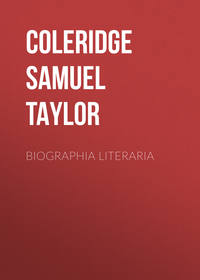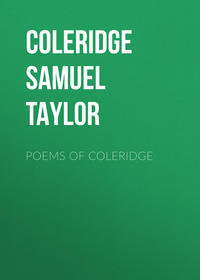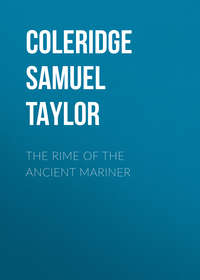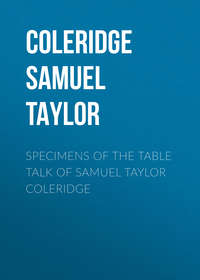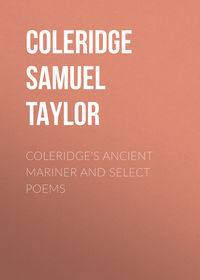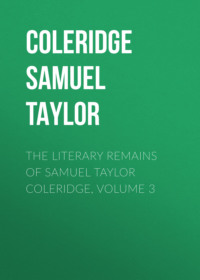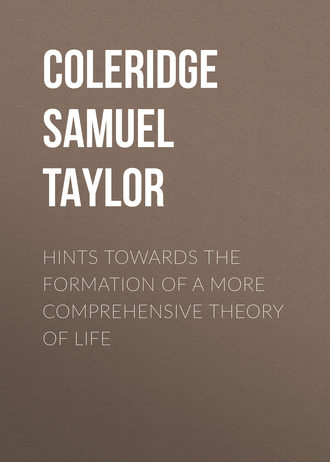 полная версия
полная версияHints towards the formation of a more comprehensive theory of life
But before we proceed further, it behoves us to answer the objections contained in the following passage, or withdraw ourselves in time from the bitter contempt in which it would involve us. Acting under such a necessity, we need not apologise for the length of the quotation.
1. “If,” says Mr. Lawrence, “the properties of living matter are to be explained in this way, why should not we adopt the same plan with physical properties, and account for gravitation, or chemical affinity, by the supposition of appropriate subtile fluids? Why does the irritability of a muscle need such an explanation, if explanation it can be called, more than the elective attraction of a salt?”
2. “To make the matter more intelligible, this vital principle is compared to magnetism, to electricity, and to galvanism; or it is roundly stated to be oxygen. 'Tis like a camel, or like a whale, or like what you please.”
3. “You have only to grant that the phenomena of the sciences just alluded to depend on extremely fine and invisible fluids, superadded to the matters in which they are exhibited, and to allow further that Life, and magnetic, galvanic, and electric phenomena correspond perfectly; the existence of a subtile matter of Life will then be a very probable inference.”
4. “On this illustration you will naturally remark, that the existence of the magnetic, electric, and galvanic fluids, which is offered as a proof of the existence of a vital fluid, is as much a matter of doubt as that of the vital fluid itself.”
5. “It is singular, also, that the vital principle should be like both magnetism and electricity, when these two are not like each other.”
6. “It would have been interesting to have had this illustration prosecuted a little further. We should have been pleased to learn whether the human body is more like a loadstone, a voltaic pile, or an electrical machine; whether the organs are to be regarded as Leyden jars, magnetic needles, or batteries.”
7. “The truth is, there is no resemblance, no analogy, between Electricity and Life; the two orders of phenomena are completely distinct; they are incommensurable. Electricity illustrates life no more than life illustrates electricity.”13
To avoid unnecessary description, I shall refer to the passages by the numbers affixed to them, for that purpose, in the margin.
In reply to No. 1, I ask whether, in the nature of the mind, illustration and explanation must not of necessity proceed from the lower to the higher? or whether a boy is to be taught his addition, subtraction, multiplication, and division, by the highest branches of algebraic analysis? Is there any better way of systematic teaching, than that of illustrating each new step, or having each new step illustrated to him by its identity in kind with the step the next below it? though it be the only mode in which this objection can be answered, yet it seems affronting to remind the objector, of rules so simple as that the complex must even be illustrated by the more simple, or the less scrutible by that which is more subject to our examination.
In reply to No. 2, I first refer to the author's eulogy on Mr. Hunter, p. 163, in which he is justly extolled for having “surveyed the whole system of organized beings, from plants to man:” of course, therefore, as a system; and therefore under some one common law. Now in the very same sense, and no other, than that in which the writer himself by implication compares himself as a man to the dermestes typographicus, or the fucus scorpioides, do I compare the principle of Life to magnetism, electricity, and constructive affinity,—or rather to that power to which the two former are the thesis and antithesis, the latter the synthesis. But if to compare involve the sense of its etymon, and involve the sense of parity, I utterly deny that I do at all compare them; and, in truth, in no conceivable sense of the word is it applicable, any more than a geometrician can be affirmed to compare a polygon to a point, because he generates the line out of the point. The writer attributes to a philosophy essentially vital the barrenness of the mechanic system, with which alone his imagination has been familiarised, and which, as hath been justly observed by a contemporary writer, is contradistinguished from the former principally in this respect; that demanding for every mode and act of existence real or possible visibility, it knows only of distance and nearness, composition (or rather compaction) and decomposition, in short, the relations of unproductive particles to each other; so that in every instance the result is the exact sum of the component qualities, as in arithmetical addition. This is the philosophy of Death, and only of a dead nature can it hold good. In Life, and in the view of a vital philosophy, the two component counter-powers actually interpenetrate each other, and generate a higher third, including both the former, “ita tamen ut sit alia et major.”
As a complete answer to No. 3, I refer the reader to many passages in the preceding and following pages, in which, on far higher and more demonstrative grounds than the mechanic system can furnish, I have exposed the unmeaningness and absurdity of these finer fluids, as applied even to electricity itself; unless, indeed, they are assumed as its product. But in addition I beg leave to remind the author, that it is incomparably more agreeable to all experience to originate the formative process in the fluid, whether fine or gross, than in corporeal atoms, in which we are not only deserted by all experience, but contradicted by the primary conception of body itself.
Equally inapplicable is No. 4: and of No. 5 I can only repeat, first, that I do not make Life like magnetism, or like electricity; that the difference between magnetism and electricity, and the powers illustrated by them, is an essential part of my system, but that the animal Life of man is the identity of all three. To whatever other system this objection may apply, it is utterly irrelevant to that which I have here propounded: though from the narrow limits prescribed to me, it has been propounded with an inadequacy painful to my own feelings.
The ridicule in No. 6 might be easily retorted; but as it could prove nothing, I will leave it where I found it, in a page where nothing is proved.
A similar remark might be sufficient for the bold and blank assertion (No. 7) with which the extract concludes; but that I feel some curiosity to discover what meaning the author attaches to the term analogy. Analogy implies a difference in sort, and not merely in degree; and it is the sameness of the end, with the difference of the means, which constitutes analogy. No one would say the lungs of a man were analogous to the lungs of a monkey, but any one might say that the gills of fish and the spiracula of insects are analogous to lungs. Now if there be any philosophers who have asserted that electricity as electricity is the same as Life, for that reason they cannot be analogous to each other; and as no man in his senses, philosopher or not, is capable of imagining that the lightning which destroys a sheep, was a means to the same end with the principle of its organization; for this reason, too, the two powers cannot be represented as analogous. Indeed I know of no system in which the word, as thus applied, would admit of an endurable meaning, but that which teaches us, that a mass of marrow in the skull is analogous to the rational soul, which Plato and Bacon, equally with the “poor Indian,” believe themselves to have received from the Supreme Reason.
It would be blindness not to see, or affectation to pretend not to see, the work at which these sarcasms were levelled. The author of that work is abundantly able to defend his own opinions; yet I should be ambitious to address him at the close of the contest in the lines of the great Roman poet:
“Et nos tela, Pater, ferrumque haud debile dextrâSpargimus, et nostro sequitur, de vulnere sanguis.”In Mr. Abernethy's Lecture on the Theory of Life, it is impossible not to see a presentiment of a great truth. He has, if I may so express myself, caught it in the breeze: and we seem to hear the first glad opening and shout with which he springs forward to the pursuit. But it is equally evident that the prey has not been followed through its doublings and windings, or driven out from its brakes and covers into full and open view. Many of the least tenable phrases may be fairly interpreted as illustrations, rather than precise exponents of the author's meaning; at least, while they remain as a mere suggestion or annunciation of his ideas, and till he has expanded them over a larger sphere, it would be unjust to infer the contrary. But it is not with men, however strongly their professional merits may entitle them to reverence, that my concern is at present. If the opinions here supported are the same with those of Mr. Abernethy, I rejoice in his authority. If they are different, I shall wait with an anxious interest for an exposition of that difference.
Having reasserted that I no more confound magnetism with electricity, or the chemical process, than the mathematician confounds length with breadth, or either with depth; I think it sufficient to add that there are two views of the subject, the former of which I do not believe attributable to any philosopher, while both are alike disclaimed by me as forming any part of my views. The first is that which is supposed to consider electricity identical with life, as it subsists in organized bodies. The other considers electricity as everywhere present, and penetrating all bodies under the image of a subtile fluid or substance, which, in Mr. Abernethy's inquiry, I regard as little more than a mere diagram on his slate, for the purpose of fixing the attention on the intellectual conception, or as a possible product, (in which case electricity must be a composite power,) or at worst, as words quæ humana incuria fudit. This which, in inanimate Nature, is manifested now as magnetism, now as electricity, and now as chemical agency, is supposed, on entering an organized body, to constitute its vital principle, something in the same manner as the steam becomes the mechanic power of the steam-engine, in consequence of its compression by the steam-engine; or as the breeze that murmurs indistinguishably in the forest becomes the element, the substratum, of melody in the Æolian harp, and of consummate harmony in the organ. Now this hypothesis is as directly opposed to my view as supervention is to evolution, inasmuch as I hold the organized body itself, in all its marvellous contexture, to be the PRODUCT and representant of the power which is here supposed to have supervened to it. So far from admitting a transfer, I do not admit it even in electricity itself, or in the phenomena universally called electrical; among other points I ground my explanation of remote sympathy on the directly contrary supposition.
But my opinions will be best explained by a rapid exemplification in the processes of Nature, from the first rudiments of individualized life in the lowest classes of its two great poles, the vegetable and animal creation, to its crown and consummation in the human body; thus illustrating at once the unceasing polarity of life, as the form of its process, and its tendency to progressive individuation as the law of its direction.
Among the conceptions, of the mere ideal character of which the philosopher is well aware, and which yet become necessary from the necessity of assuming a beginning; the original fluidity of the planet is the chief. Under some form or other it is expressed or implied in every system of cosmogony and even of geology, from Moses to Thales, and from Thales to Werner. This assumption originates in the same law of mind that gave rise to the prima materia of the Peripatetic school. In order to comprehend and explain the forms of things, we must imagine a state antecedent to form. A chaos of heterogeneous substances, such as our Milton has described, is not only an impossible state (for this may be equally true of every other attempt), but it is palpably impossible. It presupposes, moreover, the thing it is intended to solve; and makes that an effect which had been called in as the explanatory cause. The requisite and only serviceable fiction, therefore, is the representation of CHAOS as one vast homogeneous drop! In this sense it may be even justified, as an appropriate symbol of the great fundamental truth that all things spring from, and subsist in, the endless strife between indifference and difference. The whole history of Nature is comprised in the specification of the transitional states from the one to the other. The symbol only is fictitious: the thing signified is not only grounded in truth—it is the law and actuating principle of all other truths, whether physical or intellectual.
Now, by magnetism in its widest sense, I mean the first and simplest differential act of Nature, as the power which works in length, and produces the first distinction between the indistinguishable by the generation of a line. Relatively, therefore, to fluidity, that is, to matter, the parts of which cannot be distinguished from each other by figure, magnetism is the power of fixity; but, relatively to itself, magnetism, like every other power in Nature, is designated by its opposite poles, and must be represented as the magnetic axis, the northern pole of which signifies rest, attraction, fixity, coherence, or hardness; the element of EARTH in the nomenclature of observation and the CARBONIC principle in that of experiment; while the southern pole, as its antithesis, represents mobility, repulsion, incoherence, and fusibility; the element of air in the nomenclature of observation (that is, of Nature as it appears to us when unquestioned by art), and azote or nitrogen in the nomenclature of experiment (that is, of Nature in the state so beautifully allegorized in the Homeric fable of Proteus bound down, and forced to answer by Ulysses, after having been pursued through all his metamorphoses into his ultimate form.14) That nothing real does or can exist corresponding to either pole exclusively, is involved in the very definition of a THING as the synthesis of opposing energies. That a thing is, is owing to the co-inherence therein of any two powers; but that it is that particular thing arises from the proportions in which these powers are co-present, either as predominance or as reciprocal neutralization; but under the modification of twofold power to which magnetism itself is, as the thesis to its antithesis.
The correspondent, in the world of the senses, to the magnetic axis, exists in the series of metals. The metalleity, as the universal base of the planet, is a necessary deduction from the principles of the system. From the infusible, though evaporable, diamond to nitrogen itself, the metallic nature of which has been long suspected by chemists, though still under the mistaken notion of an oxyde, we trace a series of metals from the maximum of coherence to positive fluidity, in all ordinary temperatures, we mean. Though, in point of fact, cold itself is but a superinduction of the one pole, or, what amounts to the same thing, the subtraction of the other, under the modifications afore described; and therefore are the metals indecomposible, because they are themselves the decompositions of the metallic axis, in all its degrees of longitude and latitude. Thus the substance of the planet from which it is, is metallic; while that which is ever becoming, is in like manner produced through the perpetual modification of the first by the opposite forces of the second; that is, by the principle of contraction and difference at the eastern extreme—the element of fire, or the oxygen of the chemists; and by the elementary power of dilatation, or universality at its western extreme—the ὑδωρ ἐν ὑδατι of the ancients, and the hydrogen of the laboratory.
It has been before noticed that the progress of Nature is more truly represented by the ladder, than by the suspended chain, and that she expands as by concentric circles. This is, indeed, involved in the very conception of individuation, whether it be applied to the different species or to the individuals. In what manner the evident interspace is reconciled with the equally evident continuity of the life of Nature, is a problem that can be solved by those minds alone, which have intuitively learnt that the whole actual life of Nature originates in the existence, and consists in the perpetual reconciliation, and as perpetual resurgency of the primary contradiction, of which universal polarity is the result and the exponent. From the first moment of the differential impulse—(the primæval chemical epoch of the Wernerian school)—when Nature, by the tranquil deposition of crystals, prepared, as it were, the fulcrum of her after-efforts, from this, her first, and in part irrevocable, self-contraction, we find, in each ensuing production, more and more tendency to independent existence in the increasing multitude of strata, and in the relics of the lowest orders, first of vegetable and then of animal life. In the schistous formations, which we must here assume as in great measure the residua of vegetable creations, that have sunk back into the universal life, and in the later predominant calcareous masses, which are the caput mortuum of animalized existence, we ascend from the laws of attraction and repulsion, as united in gravity, to magnetism, electricity, and constructive power, till we arrive at the point representative of a new and far higher intensity. For from this point flow, as in opposite directions, the two streams of vegetation and animalization, the former characterised by the predominance of magnetism in its highest power, as reproduction, the other by electricity intensified—as irritability, in like manner. The vegetable and animal world are the thesis and antithesis, or the opposite poles of organic life. We are not, therefore, to seek in either for analogies to the other, but for counterpoints. On the same account, the nearer the common source, the greater the likeness; the farther the remove, the greater the opposition. At the extreme limits of inorganic Nature, we may detect a dim and obscure prophecy of her ensuing process in the twigs and rude semblances that occur in crystallization of some of the copper ores, and in the well-known arbor Dianæ, and arbor Veneris. These latter Ritter has already ably explained by considering the oblique branches and their acute angles as the result of magnetic repulsion, from the presentation of the same poles, &c. In the CORALS and CONCHYLIA, the whole act and purpose of their existence seems to be that of connecting the animal with the inorganic world by the perpetual formation of calcareous earth. For the corals are nothing but polypi, which are characterised by still passing away and dissolving into the earth, which they had previously excreted, as if they were the first feeble effort of detachment. The power seems to step forward from out the inorganic world only to fall back again upon it, still, however, under a new form, and under the predominance of the more active pole of magnetism. The product must have the same connexion, therefore, with azote, which the first rudiments of vegetation have with carbon: the one and the other exist not for their own sakes, but in order to produce the conditions best fitted for the production of higher forms. In the polypi, corallines, &c., individuality is in its first dawn; there is the same shape in them all, and a multitude of animals form, as it were, a common animal. And as the individuals run into each other, so do the different genera. They likewise pass into each other so indistinguishably, that the whole order forms a very network.
As the corals approach the conchylia, this interramification decreases. The tubipora forms the transition to the serpula; for the characteristic of all zoophytes, namely, the star shape of their openings, here disappears, and the tubiporæ are distinguished from the rest of the corals by this very circumstance, that the hollow calcareous pipes are placed side by side, without interbranching. In the serpula they have already become separate. How feeble this attempt is to individuate, is most clearly shown in their mode of generation. Notwithstanding the report of Professor Pallas, it still remains doubtful whether there exists any actual copulation among the polypi. The mere existence of a polypus suffices for its endless multiplication. They may be indefinitely propagated by cuttings, so languid is the power of individuation, so boundless that of reproduction. But the delicate jelly dissolves, as lightly as it was formed, into its own product, and it is probable that the Polynesia, as a future continent, will be the gigantic monument, not so much of their life, as of the life of Nature in them. Here we may observe the first instance of that general law, according to which Nature still assimilates her extreme points. In these, her first and feeblest attempts to animalize organization, it is latent, because undeveloped, and merely potential; while, in the human brain, the last and most consummate of her combined energies, it is again lost or disguised in the subtlety15 and multiplicity of its evolution.
In the class immediately above (Mollusca) we find the individuals separate, a more determinate form, and in the higher species, the rudiment of nerves, as the first scarce distinguishable impress and exponent of sensibility; still, however, the vegetative reproduction is the predominant form; and even the nerves “which float in the same cavity with the other viscera,” are probably subservient to it, and extend their power in the increased intensity of the reproductive force. Still prevails the transitional state from the fluid to the solid; and the jelly, that rudiment in which all animals, even the noblest, have their commencement; constitutes the whole sphere of these rudimental animals.
In the snail and muscle, the residuum of the coral reappears, but refined and ennobled into a part of the animal. The whole class is characterised by the separation of the fluid from the solid. On the one side, a gelatinous semi-fluid; on the other side, an entirely inorganic, though often a most exquisitely mechanised, calcareous excretion.
Animalization in general is, we know, contra-distinguished from vegetables in general by the predominance of azote in the chemical composition, and of irritability in the organic process. But in this and the foregoing classes, as being still near the common equator, or the punctum indifferentiæ, the carbonic principle still asserts its claims, and the force of reproduction struggles with that of irritability. In the unreconciled strife of these two forces consists the character of the Vermes, which appear to be the preparatory step for the next class. Hence the difficulties which have embarrassed the naturalists, who adopt the Linnæan classification, in their endeavours to discover determinate characters of distinction between the vermes and the insecta.
But no sooner have we passed the borders, than endless variety of form and the bold display of instincts announce, that Nature has succeeded. She has created the intermediate link between the vegetable world, as the product of the reproductive or magnetic power, and the animal as the exponent of sensibility. Those that live and are nourished, on the bodies of other animals, are comparatively few, with little diversity of shape, and almost all of the same natural family. These we may pass by as exceptions. But the insect world, taken at large, appears as an intenser life, that has struggled itself loose and become emancipated from vegetation, Floræ liberti, et libertini! If for the sake of a moment's relaxation we might indulge a Darwinian flight, though at the risk of provoking a smile, (not, I hope, a frown) from sober judgment, we might imagine the life of insects an apotheosis of the petals, stamina, and nectaries, round which they flutter, or of the stems and pedicles, to which they adhere. Beyond and above this step, Nature seems to act with a sort of free agency, and to have formed the classes from choice and bounty. Had she proceeded no further, yet the whole vegetable, together with the whole insect creation, would have formed within themselves an entire and independent system of Life. All plants have insects, most commonly each genus of vegetables its appropriate genera of insects; and so reciprocally interdependent and necessary to each other are they, that we can almost as little think of vegetation without insects, as of insects without vegetation. Though probably the mere likeness of shape, in the papilio, and the papilionaceous plants, suggested the idea of the former, as the latter in a state of detachment, to our late poetical and theoretical brother; yet a something, that approaches to a graver plausibility, is given to this fancy of a flying blossom; when we reflect how many plants depend upon insects for their fructification. Be it remembered, too, that with few and very obscure exceptions, the irritable power and an analogon of voluntary motion first dawn on us in the vegetable world, in the stamina, and anthers, at the period of impregnation. Then, as if Nature had been encouraged by the success of the first experiment, both the one and the other appear as predominance and general character. The insect world is the exponent of irritability, as the vegetable is of reproduction.




